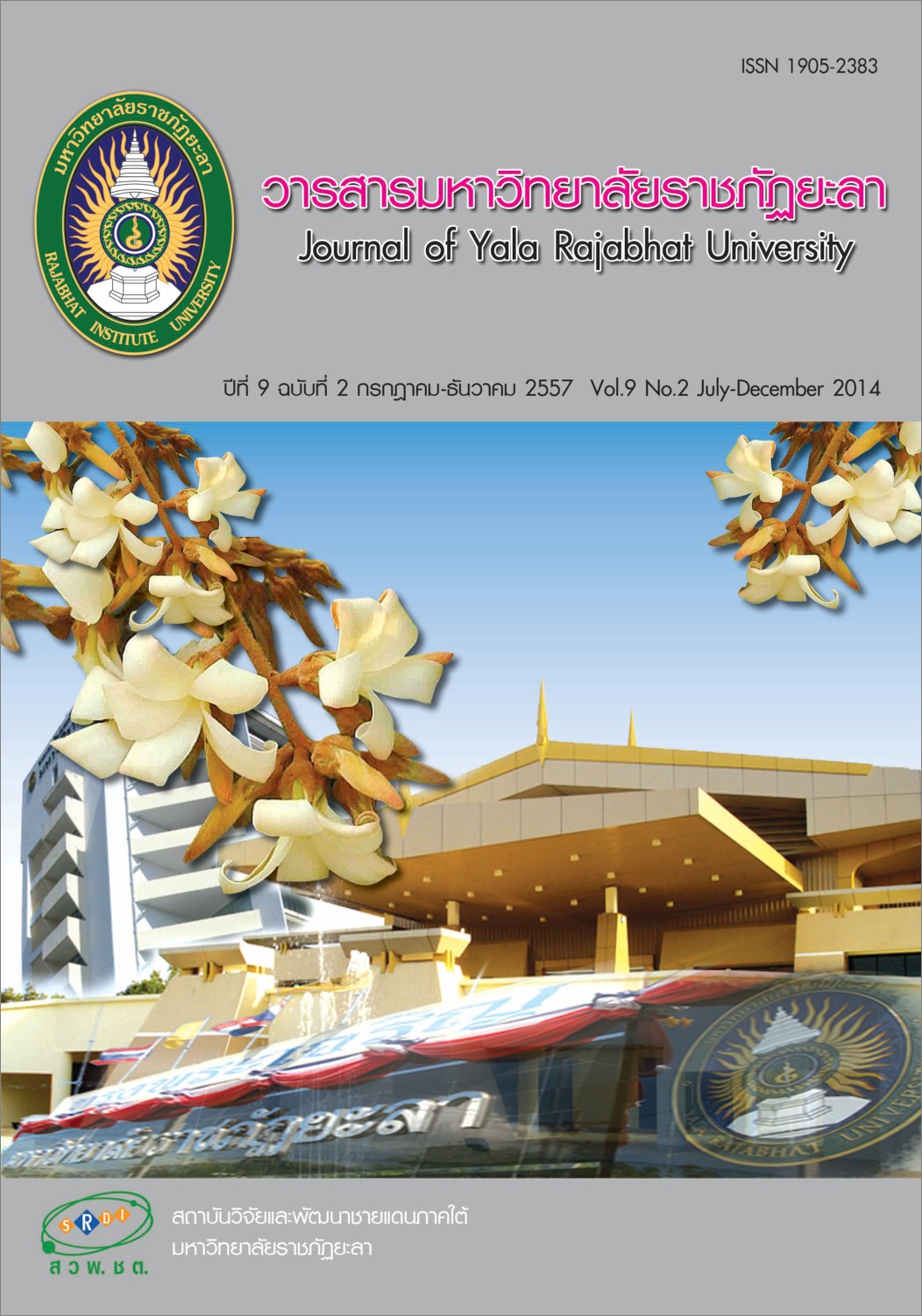การสังเกตพฤติกรรมของกวางผา (Naemorhedus griseus) ในสภาพการเพาะเลี้ยง
Main Article Content
บทคัดย่อ
การศึกษาพฤติกรรมของกวางผา (Naemorhedus griseus) ได้ทำการศึกษาที่ สถานีเพาะเลี้ยงสัตว์ป่าอมก๋อย ได้ทำการจัดกวางผาออกเป็น 3 กลุ่ม แต่ละกลุ่มประกอบด้วย ตัวเต็มวัยเพศผู้ ตัวเต็มวัยเพศเมีย และกวางผารุ่นเยาว์ (อายุประมาณ 1 ปี) กวางผาแต่ละครอบครัวจะถูกปล่อยอยู่ในคอกเลี้ยงในพื้นที่ 40 X 40 ตารางเมตร จากนั้นทำการบันทึกพฤติกรรมของกวางผาโดยวิธี Focal-Scan Sampling Method และ Descriptive Method ผลการศึกษาในสภาพการเลี้ยงกึ่งธรรมชาติพบ 6 รูปแบบพฤติกรรมที่พบเห็นได้บ่อย คือ พฤติกรรมการกินอาหาร การกินอาหารข้น การเคี้ยวเอื้อง การยืน การเดิน และ นอนพัก ซึ่งกวางผาเพศผู้ มีค่าเท่ากับ 10.83% 4.24% 7.80% 42.42% 13.11% และ 11.97% ตามลำดับ ส่วนกวางผาเพศเมียมีค่าเท่ากับ 14.24% 9.39% 6.67% 42.05% 11.97% และ 7.73% ตามลำดับ และกวางผารุ่นเยาว์มีค่าเท่ากับ และ 9.85% 3.94% 5.53% 31.74% 14.02% และ15.05% ตามลำดับส่วนการพฤติกรรมของกวางผาก่อนปละหลังสวมปลอกคอวิทยุไม่มีความแตกต่างอย่างมีนัยสำคัญทางสถิติ (p>0.05) ซึ่งแสดงให้เห็นว่า สามารถนำปลอกคอวิทยุไปใช้ในการติดตามตำแหน่งของกวางผาในพื้นที่ขนาดใหญ่ได้ การศึกษาพฤติกรรมของกวางผาในครั้งนี้สามารถนำไปใช้ประโยชน์ในการจัดการด้านการอนุรักษ์และติดตาม เพื่อเพิ่มจำนวนประชากรของกวางผาได้อย่างมีประสิทธิภาพนอกจากนี้ยังเป็นก้าวแรกของการอนุรักษ์กวางผาในป่าธรรมชาติอย่างมีประสิทธิภาพ
Article Details
บทความ ข้อมูล เนื้อหา รูปภาพ ฯลฯ ที่ได้รับการเผยแพร่ในวารสารมหาวิทยาลัยราชภัฏยะลานี้ ถือเป็นลิขสิทธิ์ของวารสารมหาวิทยาลัยราชภัฏยะลา หากบุคคลหรือหน่วยงานใดต้องการนำทั้งหมดหรือส่วนหนึ่งส่วนใดไปเผยแพร่ต่อหรือกระทำการใดๆ จะต้องได้รับอนุญาตเป็นลายลักษณ์อักษรจากวารสารมหาวิทยาลัยราชภัฏยะลาก่อนเท่านั้น
เอกสารอ้างอิง
2.Bromlei, G. F. (1956). Goral (Nemorhaedus caudatus raddeanus Heude, 1894) Zool. Zhurnal, 35, 1395-1405.
3.Bruver, W. (1973). Fauna of north Thailand. Nat. His. Bull. Siam, 24, 463–466.
4.Chaiyarat, R. (1997). Ecology of goral (Nemorhaedus goral (Hardwicke, 1825)) in Om Koi wildlife sanctuary, changwat Chiang Mai and Tak. Unpublished M. S. Thesis. Kasetsart University.
5.Chaiyarat, R., Laohajinda, W., Kutintara, U. and Nabhitabhata, J. (1999) The goral (Naemorhedus goral) in Om Koi sanctuary, Thailand. Nat. Hist. Bull. Siam, 4, 191-205.
6.Dearden, P. (1996). Development, the environment and social differentiation in northern Thailand. In: Rigg, J. (Ed.), Counting the Costs: Environmental Growth and
Economic Change. Singapore: ISEAS.
7.Department of National Park, wildlife and plant conservation. (2005). Master plan of wildlife resource conservation. Bangkok: Ministry of National Resources and Environment.
8.Dobroruka, L. J. (1968). Breeding group of gorals. Internat. Zoo Yearb, 8, 143-145.
9.Geist, V. (1971). Mountain Sheep: A Study in Behavior and Evolution. Chicago: The University of Chicago Press.
10.Gilby, I. C., Pokempner, A. A. and Wrangham R. W. (2010). A direct comparison of scan sampling methods for measuring wild chimpanzee feeding behavior. Fol. Proma. (Basel), 81, 254-264.
11.Groves, C. P. and Grubbv P. (1985) Reclassification of the Serows and Gorals (Nemorhaedus: Bovidae), 2nd ed. London: Croom Helm.
12.Hofmann, R. R. (1988). Anatomy of the Gastro-Intestinal Tract. In: Church, D.C. (ed). The Ruminant Animal: Digestive Physiology and Nutrition. New Jersey: Prentice Hall.
13.Immelmann, K. (1980). Introduction to Ethology. New York: Plenum Press.
14.IUCN (2008). IUCN red list of threatened species. Retrieved April 5, 2009, from: www.iucnredlist.org.
15.IUCN. (2013). The IUCN red list of threatened species version 2013. Retrieved August 16, 2013. from: www.iucnredlist.org.
16.Kongprempoon, A (2003). Goral behavior in semi-captive/wild, Om Koi wildlife breeding centre. Thailand: Department of National Park, Wildlife and plant
conservation.
17.Lovari, S. and Apollonio, M. (1994). On the rutting behavior of the himalayan goral Nemorhaedus goral (Hardwicke, 1825). Ethol, 12, 25–34.
18.Mead, J. I. (1989) Nemorhaedus goral : Mammalian species. Amesociety Mammal, 335, 1-5.
19.Myslenkov, A. I. and Voloshina, I. V. (1997) Sexual Behavior of Amur Goral., 2nd ed. Granada: Proc World Conf Mt Ungulates.
20.Noss, R. F., Quigleym, H. B., Hornocker, M. G., Merril, l. T. and Paquet P. C. (1996). Conservation biology and carnivore conservation in the rocky mountains. Conserv. Biol, 10, 949–963.
21.Owen, D.G. (1982). Animal Models in Parasitology. London: The MacMillian Press Ltd.
22.Riecken, U. and Rarhs, U. (1996). Use of radio telemetry for studying dispersal and habitat use of Carabus coriaceus L. Ann. Zool. Fennici, 33, 109-116.
23.Roberts, T. J. (1997). The Mammals of Pakistan. London: rnest Benn Limited.
24.Schaulskaya, N. A. (1980). Seasonal changes in plant consumption by the goral (Naemorhedus goral) in the Sikhote-Alin reservation, Russian SFSR, USSR, Rastitelnye Resursy, 16, 177-186.
25.Seddon, P. J., Armstrong, D. P. and Maloney, R. F. (2007). Developing the science of reintroduction biology. Conserv Biol, 21, 303-312.
26.Shackleton, D. M. (1997). Wild sheep and goats and their relatives: status survey and conservation action plan for Caprinae. Nat. Pak: Intl. Uni. Conserv.
27.Sheikh, M. K. and Molur, S. (2005). Status and red list of Pakistan mammals based on Pakistan’s conservation assessment and management plan for mammals. Nat. Pak: Intl. Uni. Conserv.
28.Shrock, J. L. I., Crowe, M., Fromme, D. E., Gosier, V. S., Mckenzie, R., Myers, W. and Stegeman, P. L. (1970) Minority groups in Thailand. Washington D.C.: Department of the Army.
29.Tinbergen, N. (1972). Social Behavior in Animals. London: Chapman and Hall Limited.
30.Willson, M. F. (1984) Vertebrate Natural History. Philadelphia: CBS College Publishing.
31.Wongsprasert, S. (1975) Lahu trade and commerce. J. Siam, 63, 199–219.
32.Woodroffe, R. and Ginsberg, J. R. (1997). Measures for the conservation and management of free-ranging wild dog populations. Woodroffe, R., Ginsberg, J.R., Macdonald, D.W. (eds), In the african wild dog: status, survey and conservation action plan. Switzerland: IUCN/Species Survival Commission Canid Specialist Group, Gland.
33.Xie, Y. (2006) Primary observations on rutting behavior of the captive red goral. Zoo Biology, 25, 17–123.
34.Young, G. (1967). Tracks of an Intruder. London: Souvenir Press.
35.Zhang, C. (1987). Naemorhedus cranbrooki and planted tree growth on Japanese Serow populations. Eco. Res, 8, 19-25.


